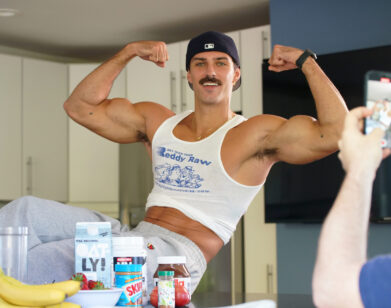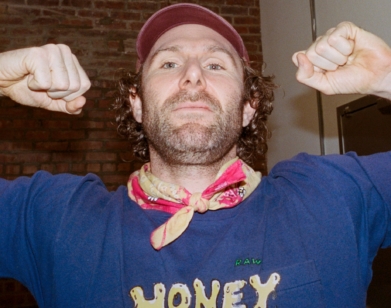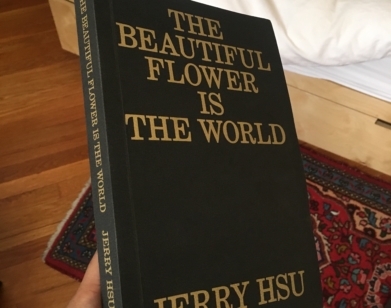texting with
Alex Olson Tells Dan Colen How Wabi-Sabi Inspired His Photos of L.A. Shopping Carts

Alex Olson is a goofy-footed skateboarder with a Hasselblad 500C camera. His debut photo book, RED—the first in a series that will nod to seven other colors of the spectrum—focuses less on the pierced denizens of his concrete milieu than it does on the objects that define their surroundings, and the people for whom those objects are home. Shot in 2012 around Los Angeles, Olson’s preferred subject here is the shopping cart, stuffed with plastic bags, teddy bears, and whatever else is picked up along the way. The proceeds of the book will support PATH, a nonprofit organization serving the homeless community of Greater Los Angeles, and the Arts for Incarcerated Youth Network. With his tender exploration of transience, privacy, concealment, and the concept of a home, Olson’s eye is a welcome addition to the coterie of skate-adjacent artists that have shaped youth culture over the last three decades. Olson shot a text to his friend and one of those artists, Dan Colen, to discuss RED, Wabi-Sabi, death, yoga, and amoebas.
———
DAN COLEN: This book is much different than I expected. I was imagining the photos depicting all the details of a person’s life. But in fact, the shopping carts are mostly draped and covered. It reminds me of how holy objects are often covered when not being used. The idea of a home which is not a house per se reminds me of the Kiswah, which is the cloth which covers the Kaaba in Mecca.
ALEX OLSON: I’ve never thought of it like that! It was more simple. That idea was more about the beauty in them and how they always change shape and you can never replicate one to form another. How it’s always forming in different ways and they become these movable statues. It’s almost the idea of wabi-sabi—finding the inner beauty in something that’s not perfect or symmetrical.
COLEN: Wabi-sabi is a great reference point. I’m very interested in creating new hierarchies around beauty, aesthetics, and the art of objecthood. There’s a lot I’m interested in unpacking here. The sculptural qualities of these are so elegant and evocative. But as you point out, they are moving, evolving. They are someone’s life. That aliveness is communicated in the images. Another thing that struck me about the photos is how beautiful they are. Again, I was expecting something more chaotic. The images are beautiful, they are very emotional and very tranquil. They feel very personal. How did this project come to be? Were you looking for these or were you just happening upon them? I’m curious if you envisioned the project before taking the photos, or if it was more organic?
OLSON: Growing up and skateboarding in West L.A., these are kind of a staple everywhere. But it started in 2012 when I would be driving to my studio in West Adams. I just started becoming really interested with these objects in some strange way. I don’t know why. I would have my Hasselblad in the trunk and pull over when I saw abandoned ones or politely ask the person if I could shoot. They would be very proud to get their card shot, usually.
COLEN: I’m interested in the public/private part of the project. I love imagining all the objects inside that make up the farm of each cart. The mysterious blobs are both everything and nothing all at once. The photos are very emotional. Do you feel like they capture the mood of the cart and its owner, or are they glimpses more into your own feelings?
OLSON: Maybe they are glimpses into my emotions that I may not even consciously know. I’m definitely a person that gravitates towards things that are worn, patina, or used. Never objects that are new. So it could very well be a view inside myself. I don’t usually live in one place for more than a few years. I would change schools almost every other year because my mother would try and find a better special ed program or personal tutors at the school. So maybe there’s a lot that I connect with emotionally that I never thought about actually until now.
COLEN: Do you think your attraction to the carts comes out of your own transient experiences? You shot all these photos in 2012, is there something about this current moment 8 years later that inspired you to finally make the book and share the images?
OLSON: No. I think I had found a place for them with Paradigm Publishing. My relationship with Theo, the owner, was an organic, natural friendship. We had talked about doing a book and I told him I had these images with an idea of a book, but maybe I wasn’t fully confident about them. Theo helped solidify that confidence in the images and the idea.

COLEN: It’s not easy to find people that can help you understand and resolve your own ideas. I really love that you brought up wabi-sabi. I wasn’t familiar with the philosophy. It’s about the beauty in imperfection, impermanence, and incompleteness. What do you think it means to preserve something so fleeting, to organize and finalize something which was so undefined and ever-changing? What relationship do you think the photos have to the actual carts, which are now long gone but most likely began changing the morning after you photographed them?
OLSON: I mean, I think that’s the best part about it all: you’ll never see it again! There’s something so oddly romantic about that, the way the East looks at death versus the West. They celebrate it! We’re in a time where digital has taken over our visual senses and we’ve become frantic collectors or nostalgic leeches to things. It’s very hard for us to appreciate something that won’t last or is here today gone tomorrow. It’s more again an Eastern philosophy. But I’m just realizing I made a book to preserve something, so intrinsically I’m a contradiction to what I just said.
COLEN: Here’s to death! I think we’ve connected on that kind of thinking before, the importance of the present moment. But of course, it’s not only your book. The moment is gone once we attempt to experience it, the contradiction is unavoidable. Photography as a whole inevitably suffers and succeeds because of this paradox. Does skateboarding give you that sense of presentness? I always love hearing about your new regimens. What’s your daily practice like today?
OLSON: I’ve been surfing a lot recently. Similar to skating, you have to obviously be present. I’ve been pretty militant about doing yoga every day during lockdown. I discovered a style called Sivananda yoga. It has pranayama into the practice, so you get the meditation with it all.

COLEN: That reminds me—when I first looked at these pictures, I thought of skating. Skaters have always used the city as a home. That’s what we do when we start skating; we move into the city. The landscape changes immediately—it starts feeling like our personal thing: we see new uses in everything. We don’t ask for permission, we just take. We take public spaces and make them private, we take private spaces and make them public. Skateboarding is about finding a use for the nonfunctional, innovating when something stops working—activating things which are unfinished, finding beauty and meaning in things no one else would. Do you think this attracted you to the craftsmen behind the carts? Do you think your interest in wabi-sabi came out of skateboarding?
OLSON: I’m glad you can recognize that in skateboarding. I feel like that part of skateboarding doesn’t get enough appreciation of having a completely different scope on landscapes. It’s hard for me to say where my appreciation comes from in terms of wabi-sabi—most definitely, it borrows from skateboarding. I think the most magnifying part is the craftsmanship. The way things are stacked and put together, taken away, and then re-introduced in another form makes it so interesting. To me, it feels like a grown amoeba.
COLEN: A grown amoeba! I like that. Tell me more about the book project. From what I understand, 100 percent of the proceeds from the book sales will go to support the homeless in L.A. and incarcerated youth. It seems like that is really integral to the vision of this book. Was it part of how you envisioned the book from the outset?

OLSON: I believe the number in Los Angeles now is over 100,000 homeless, and it’s unfortunately probably gonna go up. We had discussed what we should do when the book comes out. We both agreed that we should donate the profits to our choice of non-profit. I picked PATH, because they try to help find homes for families and individuals. They say they find 23 people new homes a week.
COLEN: That’s amazing. I’ve been trying to weave more social practice into my creative process. For a long time, I felt my studio work should steer clear of taking any specific stance or doing really anything which could serve a clear and direct function. Recently, I’ve been stepping back to rethink how my work engages its audience and the world at large. Regardless of how I search, I’m interested in searching for ways to create and/or dismantle meaning.




